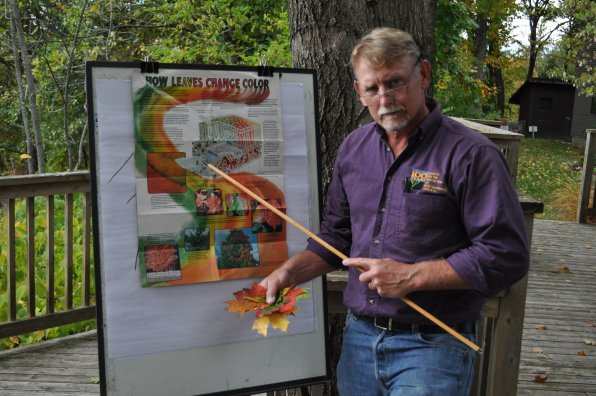In the Sept. 30 issue of the Insider, we featured a fall-themed exhibit from the Mill Brook Gallery with a caption that described the process when “trees begin to shed their summer coat in anticipation of winter.”
Apparently that didn’t meet the science accuracy standards of Dave Anderson, director of education and volunteers at the Society For The Protection of N.H. Forests, because we were greeted a few days after the paper came out by a voicemail from Anderson offering to take us to leaf school.
We went, of course, but mostly because we were hoping there’d be recess.
Class was most certainly in session, though. Anderson even made a newspaper analogy to kick things off, noting that a press runs on ink, and that ink for a tree is chlorophyll. Chlorophyll collects the sun’s rays and produces sugars and carbohydrates that keep leaves nourished.
In the fall, the rate at which the chlorophyll is breaking down exceeds the rate at which it’s being produced, he said. As the chlorophyll fades out, yellow and orange and brown hues known as carotenoids – which are present year-round but masked by green chlorophyll – are revealed.
But what about those vivid purples and reds that everyone loves so much? Those are the “rock stars of foliage,” Anderson said, not because they travel on tour buses and destroy hotel rooms but because they are the bright colors that “drive” foliage season.
Reds and purples are a result of chemicals that aren’t present throughout summer but rather produced in late summer and early fall, known as anthocyanins.
This was about the time Anderson revealed he would have given us a C- for our description, because while it contained elements of truth, it wasn’t necessarily comprehensive by science guy standards.
“They shed their leaves because they can’t do business in winter,” Anderson said. “It’s like Hampton Beach – have you ever been there in winter? You can run your fried dough or pizza stand if you want to, but nobody’s coming.”
Foliage is no small matter in New Hampshire, as evidenced by the math Anderson paired with his science. Foliage accounts for a $750 million per year business in New Hampshire, or approximately 46 percent of the $1.4 billion in outdoor recreation the state sees each year.
“It’s not just about the science of why leaves change, it’s a cultural phenomenon.”
Complete with fairy tales, like “peak foliage,” which Anderson compared to seeing Punxatawney Phil’s shadow. How does one pinpoint the precise “peak” moment, he wondered? And if you miss it in Concord, can you speed to Manchester in time to see it there?
But even with a science lesson and some myth debunking, it’s still all kind of magical, even to the pros.
“We get all caught up in the celebration of foliage, but behind it all, it’s little plant cells. It’s kind of a miracle in the leaves,” Anderson said.









